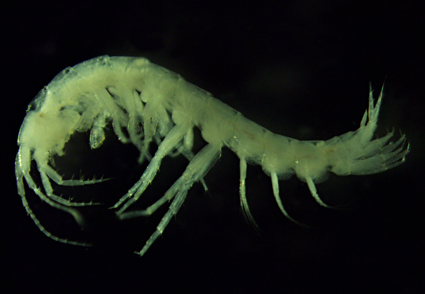Abstract
Pseudocrangonyx Akatsuka & Komai, 1922, is the most diverse group of subterranean amphipods in the groundwater communities of Far East Asia and is related to the biogeographic origin and evolution of subterranean amphipod fauna in the region. In this study, we describe two new subterranean species of pseudocrangonyctid amphipods, P. seomjinensis sp. nov. and P. danyangensis sp. nov., from the hyporheic zones in South Korea. These new species can be distinguished from their congeners by the length of the uropod 2 outer ramus, the number of accessory flagella of antenna 1, and telson shape. Additionally, we determined sequences of the nuclear 28S rRNA and the mitochondrial cytochrome c oxidase subunit I gene of the new species for molecular analyses.
References
- Akatsuka, K. & Komai, T. (1922) Pseudocrangonyx, a new genus of subterranean amphipods from Japan. Annotationes Zoologicae Japonenses, 10, 119–126.
- Folmer, O., Black, M., Hoeh, W., Lutz, R. & Vrijenhoek, R. (1994) DNA primers for amplification of mitochondrial cytochrome c oxidase subunit I from diverse metazoan invertebrates. Molecular Marine Biology and Biotechnology, 3, 294–299.
- Holsinger, J.R. (1989) Allocrangonyctidae and Pseudocrangonyctidae, two new families of Holarctic subterranean amphipod crustaceans (Gammaridea), with comments on their phylogenetic and zoogeographic relationships. Proceedings of the Biological Society of Washington, 102, 947–959.
- Holsinger, J.R. (1993) Biodiversity of subterranean amphipod crustaceans: global patterns and zoogeographic implications. Journal of Natural History, 27, 821–835. https://doi.org/10.1080/00222939300770501
- Holsinger, J.R. (1994) Pattern and process in the biogeography of subterranean amphipods. Hydrobiologia, 287, 131–145. https://doi.org/10.1007/bf00006902
- Hou, Z., Fu, J. & Li, S. (2007) A molecular phylogeny of the genus Gammarus (Crustacea: Amphipoda) based on mitochondrial and nuclear gene sequences. Molecular Phylogenetics and Evolution, 45, 596–611. https://doi.org/10.1016/j.ympev.2007.06.006
- Katoh, K. & Standley, D.M. (2013) MAFFT multiple sequence alignment software version 7: improvements in performance and usability. Molecular Biology and Evolution, 30, 772–780. https://doi.org/10.1093/molbev/mst010
- Kumar, S., Stecher, G., Li, M., Knyaz, C. & Tamura, K. (2018) MEGA X: molecular evolutionary genetics analysis across computing platforms. Molecular Biology and Evolution, 35, 1547–1549. https://doi.org/10.1093/molbev/msy096
- Lanfear, R., Frandsen, P.B., Wright, A.M., Senfeld, T. & Calcott, B. (2017) PartitionFinder 2: New methods for selecting partitioned models of evolution for molecular and morphological phylogenetic analyses. Molecular Biology and Evolution, 34, 772–773. https://doi.org/10.1093/molbev/msw260
- Lee, C.-W., Tomikawa, K., Nakano, T. & Min, G.-S. (2018) A new species of the genus Pseudocrangonyx (Crustacea, Amphipoda, Pseudocrangonyctidae) from Korea. ZooKeys, 735, 27–44. https://doi.org/10.3897/zookeys.735.21697
- Nguyen, L.T., Schmidt, H.A., Von Haeseler, A. & Minh, B.Q. (2015) IQ-TREE: a fast and effective stochastic algorithm for estimating maximum-likelihood phylogenies. Molecular biology and evolution, 32, 268–274. https://doi.org/10.1093/molbev/msu300
- Rambaut, A., Drummond, A.J., Xie, D., Baele, G. & Suchard, M.A. (2018) Posterior summarization in Bayesian phylogenetics using Tracer 1.7. Systematic Biology, 67, 901–904. https://doi.org/10.1093/sysbio/syy032
- Ronquist, F., Teslenko, M., van der Mark, P., Ayres, D.L., Darling, A., Höhna, S., Larget, B., Liu, L., Suchard, M.A. & Huelsenbeck, J.P. (2012) MrBayes 3.2: efficient Bayesian phylogenetic inference and model choice across a large model space. Systematic Biology, 61, 539–542. https://doi.org/10.1093/sysbio/sys029
- Shintani, A., Umemura, S., Nakano, T. & Tomikawa, K. (2023) A new species of the genus Pseudocrangonyx (Crustacea: Amphipoda: Pseudocrangonyctidae) from subterranean waters of Japan. Zootaxa, 5301 (3), 383–396. https://doi.org/10.11646/zootaxa.5301.3.4
- Sidorov, D. & Holsinger, J.R. (2007) Procrangonyx stygoedincus, a new species of subterranean amphipod (pseudocrangonyctidae) from the far east of Russia, with remarks on biogeographic relationships. Crustaceana, 80, 417–430. https://doi.org/10.1163/156854007780440984
- Stock, J.H. (1974) The systematics of certain Ponto-Caspian Gammaridae (Crustacea, Amphipoda). Mitteilungen aus dem Hamburgischen Zoologischen Museum und Institut, 70, 75–95.
- Väinölä, R., Witt, J., Grabowski, M., Bradbury, J.H., Jazdzewski, K. & Sket, B. (2008) Global diversity of amphipods (Amphipoda; Crustacea) in freshwater. Hydrobiologia, 595, 241–255. https://doi.org/10.1007/s10750-007-9020-6
- Zhao, S. & Hou, Z. (2017) A new subterranean species of Pseudocrangonyx from China with an identification key to all species of the genus (Crustacea, Amphipoda, Pseudocrangonyctidae). ZooKeys, 647, 1–22. https://doi.org/10.3897/zookeys.647.11192


